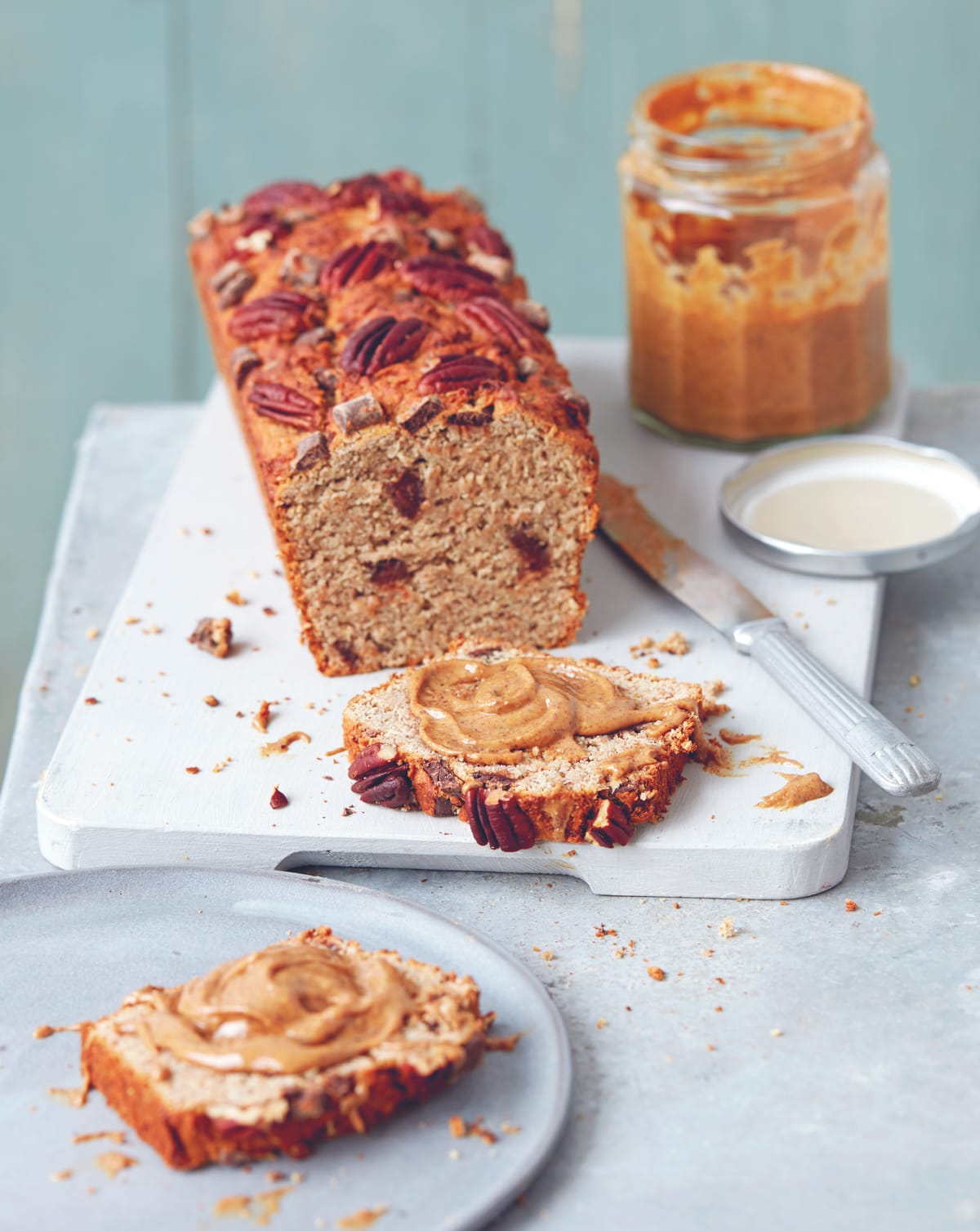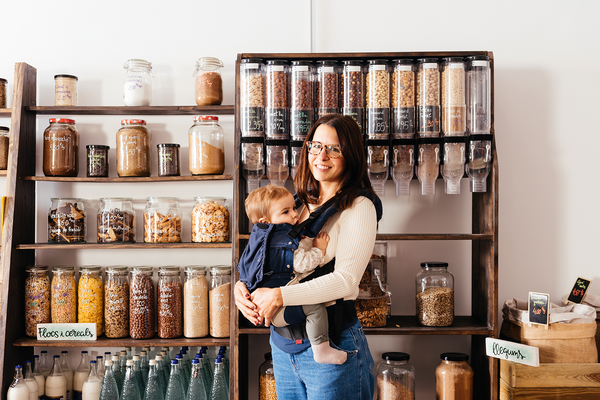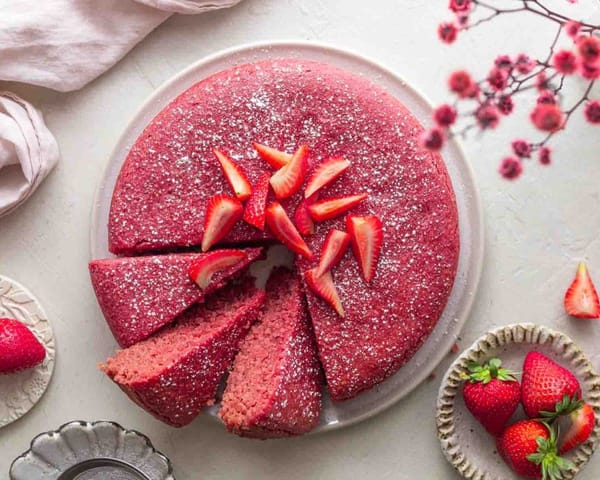Something special happens when you blend good, fresh plant foods with great flavours – you actually begin craving these dishes day after day, not only for how they taste but also for how they make you feel says Leah Vanderveldt
Plant-based comfort food is all about combining healthful ingredients in ways that make you feel all warm and fuzzy on both a physical and mental level. Using robust flavours, varying textures and being generous with ingredients are some of the key secrets to creating meals that are the perfect combination of satisfying and nourishing.
It makes me feel like I’m taking care of myself in a very tangible way – feeling well-fed and content is what I strive for in life, and this style of cooking is how I get there.
HERE ARE A FEW THINGS THAT I DON’T DO!
1 Count calories I don’t count calories. Personally, I don’t think it’s a sustainable or joyful way to live. I think focusing on eating to feel satisfied and at peace with what’s on your plate is far more beneficial.
2 Label things ‘Guilt-free food’ Guilt-free implies there should be guilt present in our relationship to food, an ethos which I strongly disagree with. I don’t believe in associating ‘good’ or ‘bad’ connotations with food.
3 Ban foods (or diet) Whilst I encourage use of whole, unprocessed foods the majority of the time, the truth is that all food has a place in our lives. Sure, some foods are more nutrient- dense than others, but I’m careful to say that those are not always the best ones for us.
As with anything, healthy eating can be taken too far. Stressing about eating the ‘right’ or ‘wrong’ thing doesn’t feel good. Food is at the heart of our everyday lives and deserves to be fully embraced.
AND HERE ARE A FEW THINGS I SAY A BIG YES TO:
1 Plant-based whole foods It’s pretty clear that vegetables, fruits, legumes, nuts and whole grains are good for our health and sustained well-being. If we can base the majority of our meals around nourishing, nutrient-dense plants, we’re likely to reap all kinds of benefits that improve the quality of our lives – like better digestion, more energy and clear headedness.
2 Seasoning and citrus Seasoning is the key to making vegetables and plant-based foods taste good. If you’re cooking your own food from scratch rather than eating processed foods, you can afford to use a little more salt.
I urge you to season to taste. If something tastes a little meh, try adding a pinch more salt or a squeeze of fresh lemon juice to it. Chances are, it’s one of those two things that can really make a dish shine.
3 Finding your feel-good point I guess this could also be classified as self- care, but self-care can sound like a vague chore that may or may not involve taking a bath. Finding your feelgood point is about tuning in to what makes you feel energized, satiated and happy, and doing more of that.
Comfort should be about what makes you feel cared for and peaceful. This means taking the time to create meals with fresh ingredients that are both substantial and, most importantly, delicious.
At the end of the day, cooking and eating should be about making you feel your best.
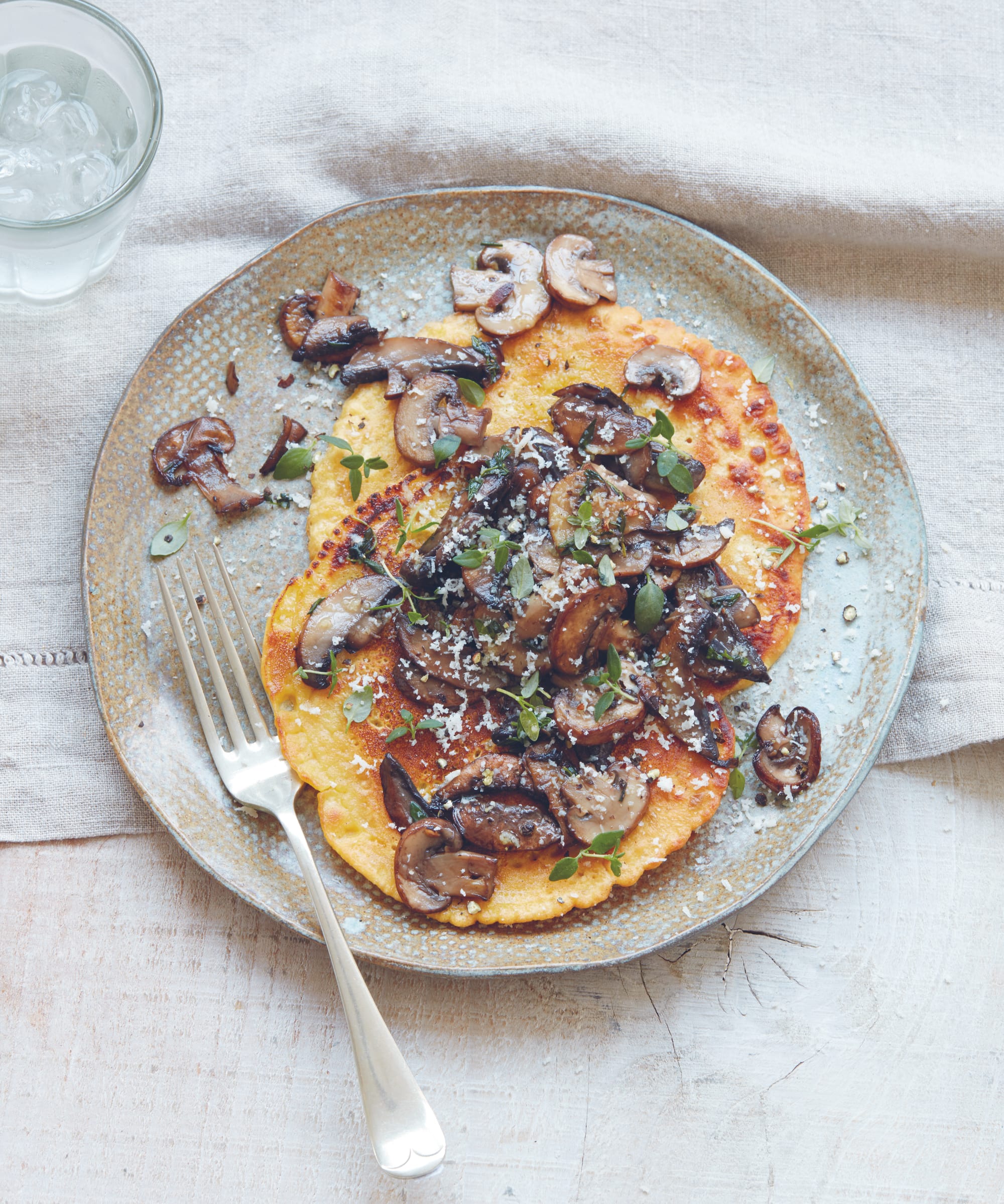
Chickpea Socca Pancakes with Mushrooms & Thyme
Socca are crispy-edged Mediterranean pancakes made with chickpea (gram) flour. They are perfect for topping with savoury or sweet ingredients. Slightly thicker than crepes, socca have a nutty-sweet flavour and a high protein content which makes them more of a wholesome, filling meal. They can be eaten for a fancy-ish breakfast or a laid-back dinner with a big green salad on the side. In this recipe, I pair the socca with earthy mushrooms, but you can play around with whatever fillings you’d like. I also like these with roasted tomatoes, or coconut yogurt and sliced fruit.
• 125 g chickpea flour
• ½ teaspoon salt
• Olive oil, for frying
For the mushrooms
• 1 tablespoon olive oil
• 5 sprigs of fresh thyme, leaves removed from the stems
• 225 g cremini mushrooms, sliced
• 1 garlic clove, finely minced or grated
• Salt and freshly ground black pepper, to taste
1 Put the chickpea flour, salt and 295 ml water into a large bowl and mix together with a whisk or a fork until well combined into a smooth batter. Leave to stand at room temperature for at least 10 minutes.
2 Meanwhile, heat a thin layer of oil in a large frying pan over a high heat. Add the thyme leaves and mushrooms and cook, stirring occasionally, for 2–3 minutes until the mushrooms soften and are slightly golden. Reduce the heat to medium, then add the garlic and cook for 1 minute more.
Season to taste with salt and pepper. Keep the mushrooms warm in a low oven or in a covered dish while you cook the pancakes.
3 Heat the olive oil in another small frying pan over a medium heat. Add approximately 60–75 ml of the socca batter to the warm pan. Swirl it around so that it covers the base of the pan. Fry for about 2–3 minutes, until the batter begins to form bubbles. Flip the pancake with a spatula and cook for another 1–2 minutes on the other side.
4 Repeat with the remaining batter. This should make you about 4 small socca pancakes in total. Serve with the mushrooms and any additional toppings you like.
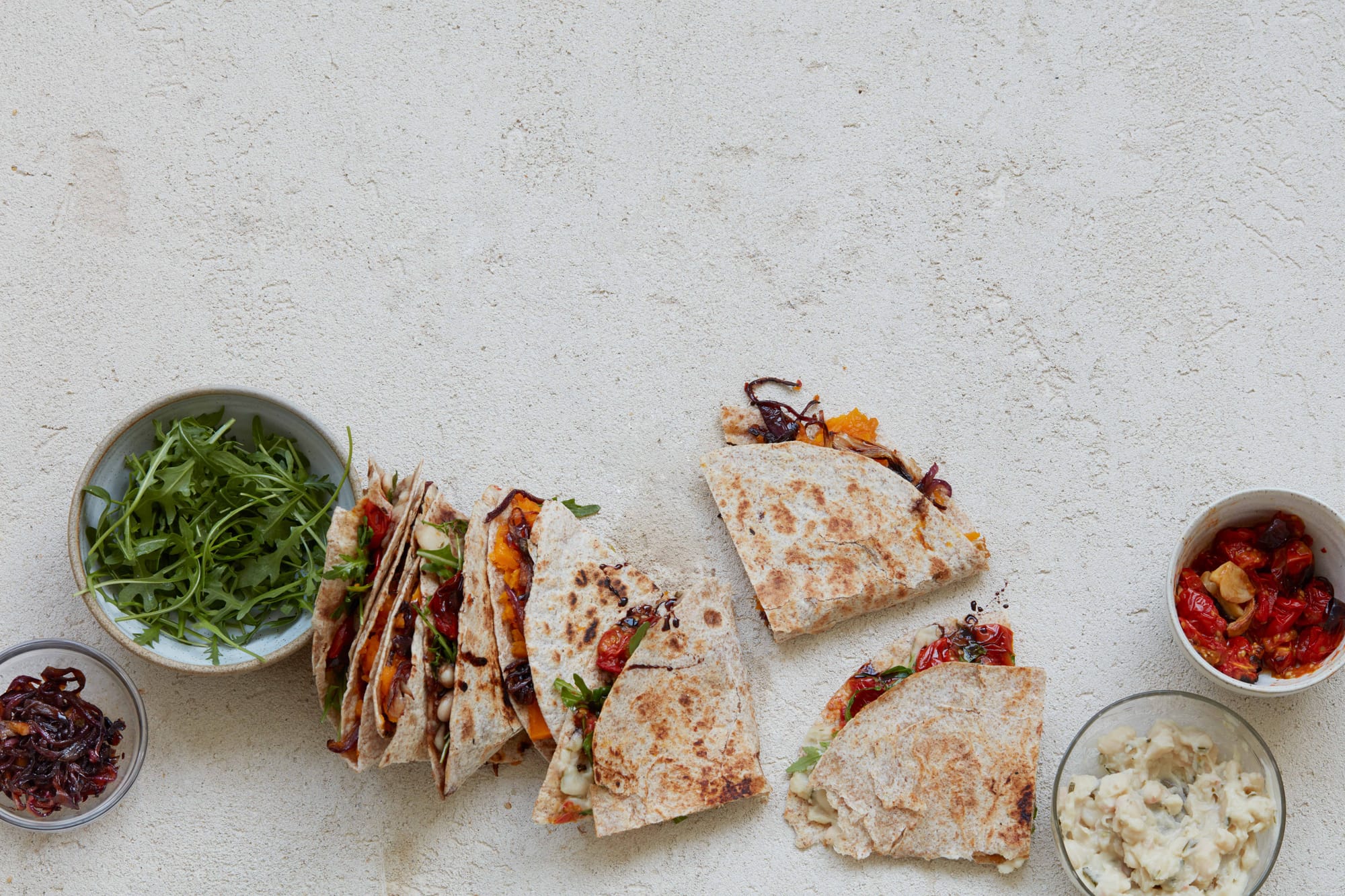
Piadinas
Piadinas are basically an Italian version of a quesadilla – toasted tortillas folded and filled with modest amounts of flavourful ingredients. I was first introduced to them when I was living in Bondi Beach in Sydney. There’s a tiny little spot (called La Piadina) a couple of streets away from the ocean that serves up freshly made piadina with top quality Italian goodies. Here’s my own plant-centric version.
For the butternut & fennel filling
• 1 fennel bulb, sliced lengthwise into thin 1.5-cm pieces
• 250 g diced butternut squash
• Salt, to taste
• Caramelized onions
For the white bean & balsamic filling
• 120 ml balsamic vinegar
• 250 g canned white beans, drained and rinsed
• 1 teaspoon freshly chopped rosemary
• 2 teaspoons olive oil
• Roasted tomatoes with garlic
• 1–2 handfuls of baby rocket/arugula
For The Piadinas
• 8 spelt or whole-wheat wraps or tortillas
• A baking tray, oiled
1 Preheat the oven to 200°C.
2 Arrange the fennel slices on the prepared baking tray and roast in the preheated oven for 20–25 minutes, flipping the slices halfway through.
3 Meanwhile, steam or boil the butternut squash cubes for about 8–10 minutes until tender. Drain, if needed, and season with salt. Set aside.
4 Put the balsamic vinegar in a small saucepan over a medium heat. Simmer for about 5 minutes until reduced by half and syrupy. Set aside until needed.
5 Place the white beans and rosemary in a medium saucepan with 60 ml of water. Season with salt and cook over a medium heat, stirring, for about 5 minutes. While you’re stirring, lightly mash the white beans with a fork, adding a little more water if the mixture gets too dry. Remove from the heat when the water has thickened and continue to mash with a fork until most of the beans are broken apart. Stir in the olive oil and add extra salt to taste, if needed.
6 When you have finished preparing one or both of your fillings, heat a cast iron pan or griddle pan over a medium heat. Place a wrap on the dry pan for about 2 minutes until starting to brown. Flip the wrap over.
7 Add your chosen filling on one half of the wrap, but don’t overstuff. The butternut squash should be slightly mashed down on the wrap with a fork to make sure it stays put. Top the butternut with the roasted fennel and some caramelized onions.
8 For the white bean and balsamic filling, spread a couple of heaped spoonfuls of beans onto one half of the wrap, top with roasted tomatoes, rocket/arugula and a little syrupy balsamic.
9 Fold the other half of the wrap over to create a semi-circle with the filling inside. Flip to make sure the wrap is golden brown and slightly crispy on both sides. Slice in half and serve warm. Repeat with the remaining wraps and fillings.
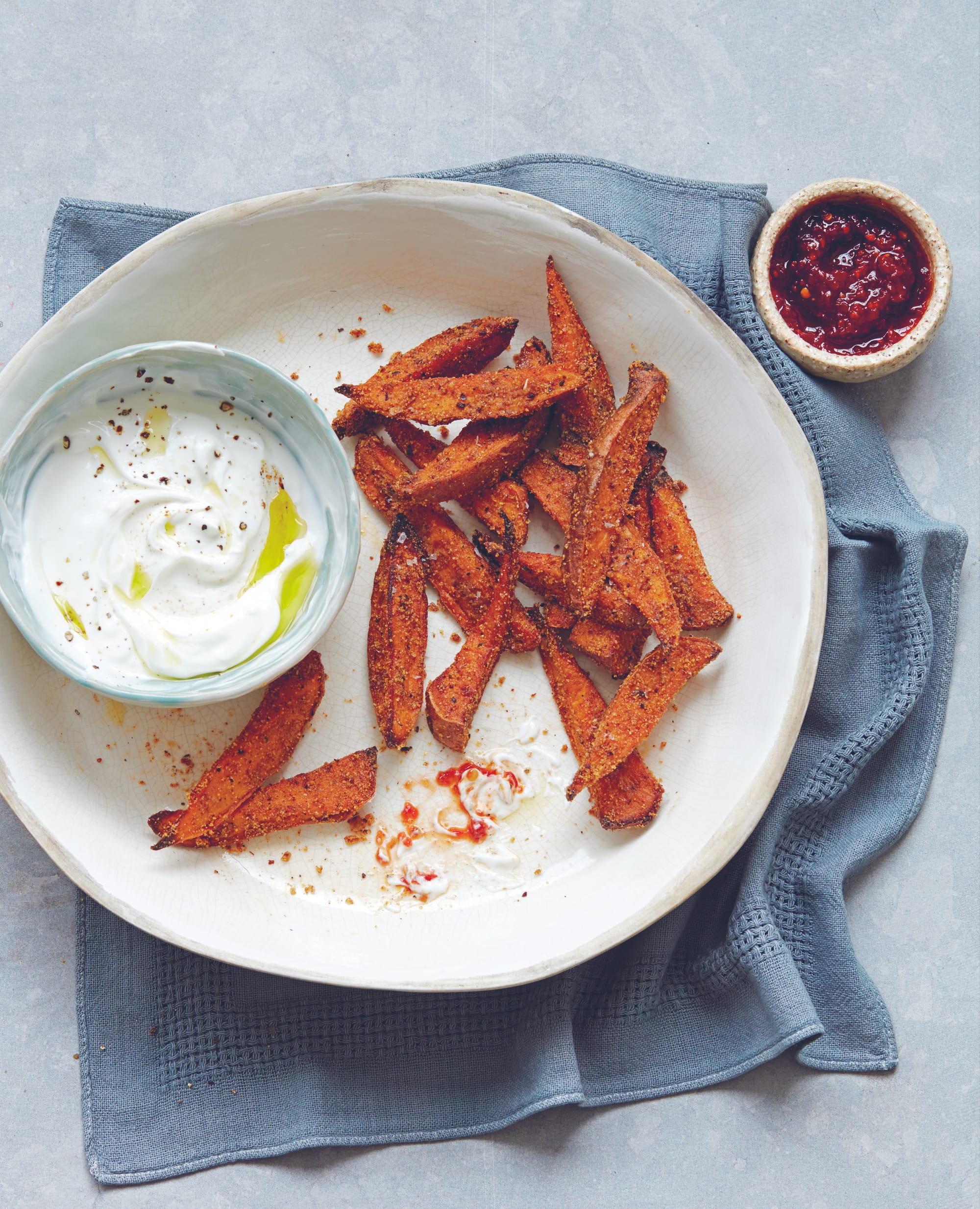
Sweet potato wedges with garlic yogurt sauce
A step up from fries or crisps/chips, wedges have a bit more heft to them, often have more seasoning, and actually resemble a potato with a bit of skin still visible. Coconut yogurt made savoury with a little salt, garlic and olive oil is the perfect dip. It’s similar to sour cream, but you get a good probiotic and protein bump from the yogurt.
• 2 sweet potatoes, scrubbed clean and cut lengthwise into 2.5-cm wedges
• 1 tablespoon olive oil
• 1 tablespoon Cajun spice blend
• 1 tablespoon polenta (optional)
• Salt, to taste
1 Preheat the oven to 220°C.
2 In a large bowl, toss the sweet potato wedges with the oil to evenly coat. Sprinkle with your chosen spice blend and the polenta. Season with salt to taste and toss again to coat the potatoes well.
3 Lay out the wedges on two baking trays, leaving at least 2.5 cm in between each piece. If you only have one tray, do it in two batches.
4 Bake in the preheated oven for 15 minutes. Remove from the oven and flip the sweet potatoes over. Bake for another 10–15 minutes. The wedges should be golden, a little crispy on the outside and soft on the inside.
5 Serve the sweet potato wedges warm with garlic yogurt dip and hot sauce or sweet chilli sauce, if desired.
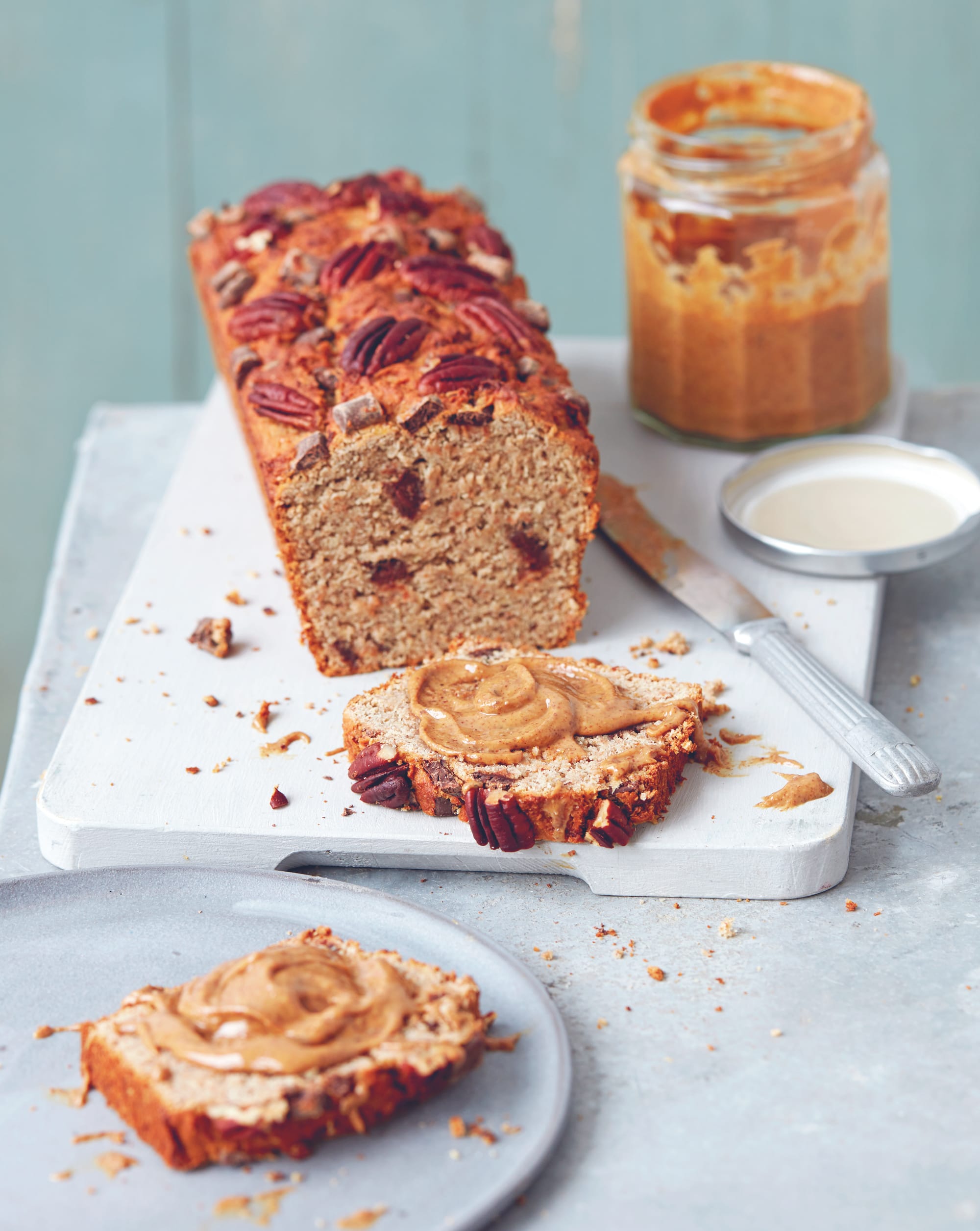
Chocolate banana bread
Until I met my husband, banana flavoured anything just wasn’t my thing. Somehow his love of a banana chocolate pairing rubbed off on me, and I find myself in the mood for this banana bread all the time. You can definitely eat this for breakfast – it’s free of refined sugar and dairy and high in fibre – and a little scattering of chocolate never ruined anyone’s morning! It’s great with some peanut or almond butter spread on a slice, too.
- 130 g whole-wheat flour
- 100 g almond flour
- 50 g oat flour (or 70 g oats, finely ground)
- 3 teaspoons baking powder
- 1 teaspoon ground cinnamon
- ½ teaspoon ground nutmeg
- ½ teaspoon salt
- 3 large bananas (overripe is best)
- 90 ml melted coconut oil, plus extra for greasing
- 60 ml almond milk
- 1 teaspoon vanilla extract
- 60 ml maple syrup
- 80 g 70% dark chocolate chips or roughly chopped chocolate
- 30 g pecans or walnuts
- Nut butter or vanilla ice cream, to serve (optional)
- 12 x 23-cm/9 x 5-inch loaf pan, greased with coconut oil
1 Preheat the oven to 180°C.
2 Mix together the dry ingredients (flours, baking powder, spices and salt) in a medium bowl.
3 Mash the bananas in another bowl, then add the melted coconut oil, almond milk, vanilla and maple syrup and mix everything together using a rubber spatula.
4 Gradually mix the dry ingredients into the banana mixture until everything is well combined. Fold in the chocolate chips.
5 Pour the batter into the prepared loaf pan and sprinkle the top with the pecans or walnuts. Bake the loaf in the preheated oven for 45–50 minutes, rotating halfway through the cooking time.
6 Remove from the oven and leave to cool to room temperature in the pan before turning out. Serve toasted with nut butter for breakfast, or warm with vanilla ice cream for dessert.
MORE INSPIRATION
READ The Vital Vegan: More than 100 vibrant plant-based recipes to energise and nourish by Leah Vanderveldt
PHOTOGRAPHY: Clare Winfield


